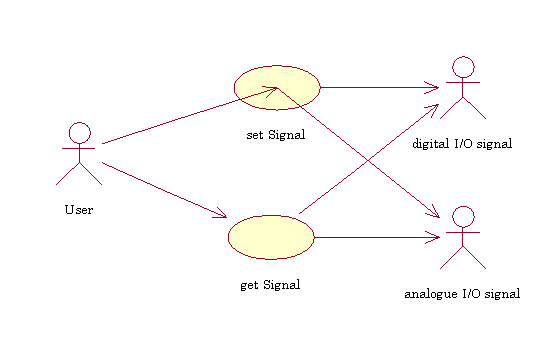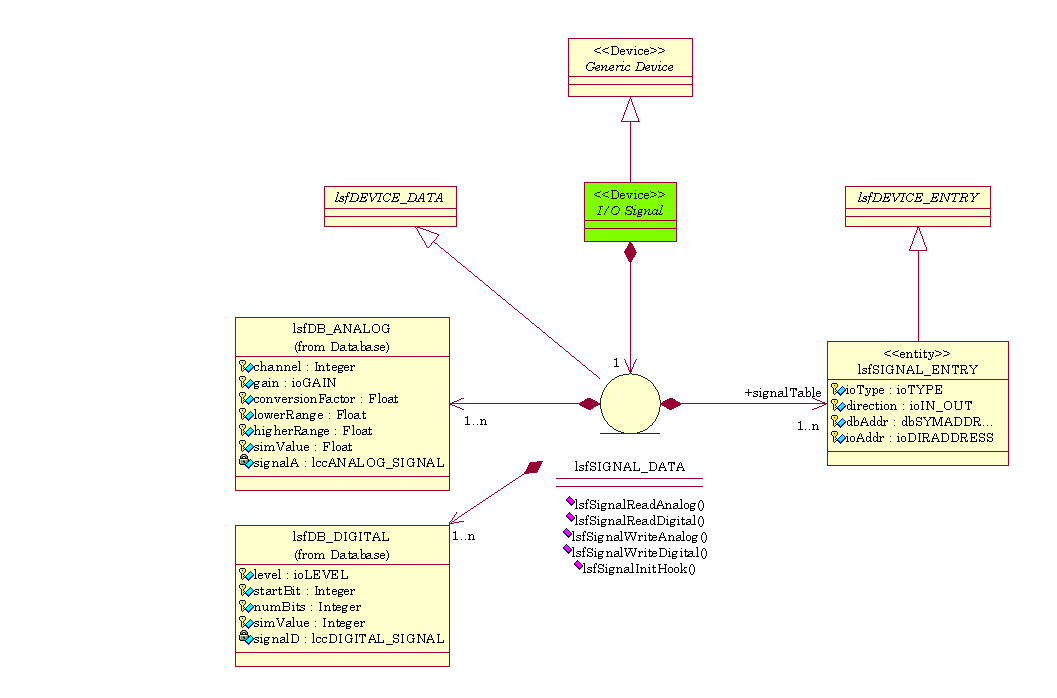Class Name:
<<Device>>lsfSIGNAL
Description:
Control of the I/O Signals (Analogue or Digital) used by a sub-system.
Inheritance:
LCU Server Framework <<Device>>lsfDEVICE
Use Case diagram:

Class diagram:

Architecture:
The <<Device>> class I/O Signal
is a wrapper to the LCC Signal handling. This class is the parent
class of the sub-classes <<Device>>lsfANALOG and <<Device>>
class lsfDIGITAL specialized for
the handling of the Analogue, resp. Digital I/O signals.
The public methods are:
- setSignal(): Output only; set
the signal to the given value.
- getSignal(): return
the actual signal value.
These 2 virtual methods correspond to the device methods:
- lsfSignalReadAnalog(): read
the voltage of specified analog signal
- lsfSignalWriteAnalog(): set
the voltage of the specified analog signal
- lsfSignalReadDigital(): read
the data bits of specified digital signal
- lsfSignalWriteDigital(): set
the data bits of the specified digital signal
The protected methods are:
- lsfSignalConstructor():
this method allocates all the resources needed by the
device. Especially it checks the availability of the associated IO
board(s), resolves the database direct addresses of the
signal points.
- lsfSignalDestructor(): this
method releases all the allocated resources.
- lsfSignalInit():
- lsfSignalStandby():
- lsfSignalOnline():
- lsfSignalStop():
- lsfSignalOff():
- lsfSignalExit():
- lsfSignalSimulat():
- lsfSignalStopsim():
- lsfSignalSelftest():
- lsfSignalTest(): these
methods implement the minimum behaviour associated to the
Standard Commands for this type of device.
The signals are configured during the Initialization of the device
according to the database attributes.
The private methods are:
- lsfSignalCallHook(): this
method is invoked at INIT and allows the application to set the
output signals to the required state prior to proceed with the
state transitions. It might be usefull for powering up some
other HW parts which shall be controlled later on (as the
signals are the first devices to be initialized).
The public attributes are:
- lsfDIGITAL:state: input
or output data bits.
- lsfANALOG:voltage: input
or output voltage.
The private attributes are:
- name: name of the
signal device
- direction: direction indicator
of the signal (Input or Output).
- deviceName: name of the
associated IO board
- simValue: simulated
value for input signal
- lsfDIGITAL:level: signal
logical level (active High or Low).
- lsfDIGITAL:startBit: first bit
of the signal on the board (from 0 to 63).
- lsfDIGITAL:numBits: number of
bits mapping the signal (up to 64)
- lsfANALOG:channel: channel on IO board (0 to
15 for input; 0,1 for output signals)
associated to the signal
- lsfANALOG:gain: gain
factor (1, 10, 100 or 500)
- lsfANALOG:conversionFactor: converts the
returned value from hardware units to user units
- lsfANALOG:lowerRange:
- lsfANALOG:higherRange: lower and higher
range for output signals
Related Packages:
- lcc: The LCU Common Software
- and the associated drivers (aio
and acro).
Issues to be Determined or Resolved: None
Last modified: Mon Sep 18 16:50:42 METDST 2000


